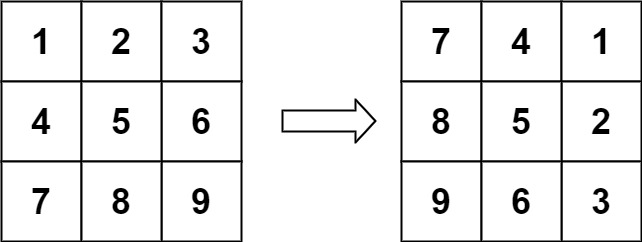You are given an n x n 2D matrix representing an image, rotate the image by 90 degrees (clockwise).
You have to rotate the image in-place, which means you have to modify the input 2D matrix directly. DO NOT allocate another 2D matrix and do the rotation.
Example 1:

Input: matrix = [[1,2,3],[4,5,6],[7,8,9]]
Output: [[7,4,1],[8,5,2],[9,6,3]]
Example 2:

Input: matrix = [[5,1,9,11],[2,4,8,10],[13,3,6,7],[15,14,12,16]]
Output: [[15,13,2,5],[14,3,4,1],[12,6,8,9],[16,7,10,11]]
Constraints:
n == matrix.length == matrix[i].length1 <= n <= 20-1000 <= matrix[i][j] <= 1000
在计算机图像处理里,旋转图片是很常见的,由于图片的本质是二维数组,所以也就变成了对数组的操作处理,翻转的本质就是某个位置上数移动到另一个位置上,比如用一个简单的例子来分析:
1 2 3 7 4 1
4 5 6 --> 8 5 2
7 8 9 9 6 3
对于90度的翻转有很多方法,一步或多步都可以解,先来看一种直接的方法,这种方法是按顺时针的顺序去覆盖前面的数字,从四个顶角开始,然后往中间去遍历,每次覆盖的坐标都是同理,如下:
(i, j) <- (n-1-j, i) <- (n-1-i, n-1-j) <- (j, n-1-i)
这其实是个循环的过程,第一个位置又覆盖了第四个位置,这里i的取值范围是 [0, n/2),j的取值范围是 [i, n-1-i),至于为什么i和j是这个取值范围,为啥i不用遍历 [n/2, n),若仔细观察这些位置之间的联系,不难发现,实际上j列的范围 [i, n-1-i) 顺时针翻转 90 度,正好就是i行的 [n/2, n) 的位置,这个方法每次循环换四个数字,如下所示:
1 2 3 7 2 1 7 4 1
4 5 6 --> 4 5 6 --> 8 5 2
7 8 9 9 8 3 9 6 3
解法一:
class Solution {
public:
void rotate(vector<vector<int>>& matrix) {
int n = matrix.size();
for (int i = 0; i < n / 2; ++i) {
for (int j = i; j < n - 1 - i; ++j) {
int tmp = matrix[i][j];
matrix[i][j] = matrix[n - 1 - j][i];
matrix[n - 1 - j][i] = matrix[n - 1 - i][n - 1 - j];
matrix[n - 1 - i][n - 1 - j] = matrix[j][n - 1 - i];
matrix[j][n - 1 - i] = tmp;
}
}
}
};
还有一种解法,首先以次对角线为轴翻转,然后再以x轴中线上下翻转即可得到结果,如下图所示(其中蓝色数字表示翻转轴):
1 2 3 9 6 3 7 4 1
4 5 6 --> 8 5 2 --> 8 5 2
7 8 9 7 4 1 9 6 3
解法二:
class Solution {
public:
void rotate(vector<vector<int>>& matrix) {
int n = matrix.size();
for (int i = 0; i < n - 1; ++i) {
for (int j = 0; j < n - i; ++j) {
swap(matrix[i][j], matrix[n - 1- j][n - 1 - i]);
}
}
reverse(matrix.begin(), matrix.end());
}
};
最后再来看一种方法,这种方法首先对原数组取其转置矩阵,所谓转置矩阵就是以主对角线为轴翻转,然后把每行的数字翻转可得到结果,如下所示(其中蓝色数字表示翻转轴,Github 上可能无法显示颜色,请参见博客园上的帖子):
1 2 3 1 4 7 7 4 1
4 5 6 --> 2 5 8 --> 8 5 2
7 8 9 3 6 9 9 6 3
解法三:
class Solution {
public:
void rotate(vector<vector<int>>& matrix) {
int n = matrix.size();
for (int i = 0; i < n; ++i) {
for (int j = i + 1; j < n; ++j) {
swap(matrix[i][j], matrix[j][i]);
}
reverse(matrix[i].begin(), matrix[i].end());
}
}
};
Github 同步地址:
https://github.com/grandyang/leetcode/issues/48
类似题目:
Determine Whether Matrix Can Be Obtained By Rotation
参考资料:
https://leetcode.com/problems/rotate-image/
https://leetcode.com/problems/rotate-image/discuss/18895/Clear-Java-solution
https://leetcode.com/problems/rotate-image/discuss/18872/A-common-method-to-rotate-the-image
LeetCode All in One 题目讲解汇总(持续更新中…)
(欢迎加入博主的知识星球,博主将及时答疑解惑,并分享刷题经验与总结,快快加入吧~)
微信打赏
 |
|
Venmo 打赏

—|—
转载请注明来源于 Grandyang 的博客 (grandyang.com),欢迎对文章中的引用来源进行考证,欢迎指出任何有错误或不够清晰的表达。可以在下面评论区评论,也可以邮件至 grandyang@qq.com





